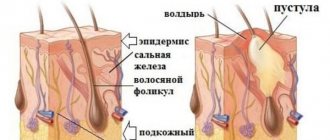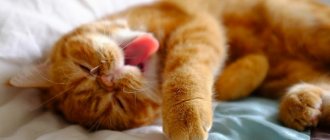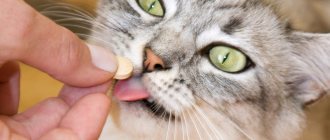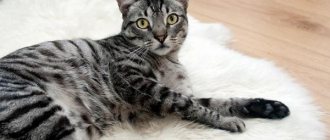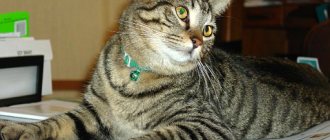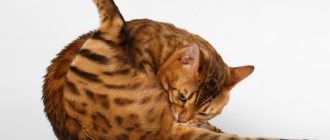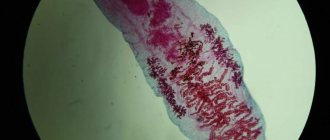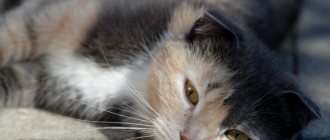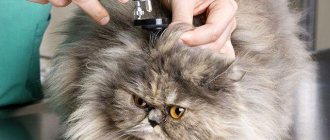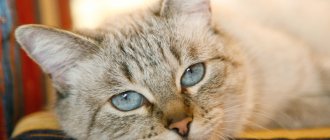Functions of the paraanal glands. The anal glands are two small sacs that contain a secretion secreted by cats for two purposes - to mark territory and for bowel movements. The secretion contains pheromones and has a very unpleasant odor for humans, and for other animals it serves as a signal that the territory is occupied or that the animal is looking for a partner for mating.
When performing an act of defecation, the glands are compressed, causing a small release of secretion into the sphincter, thereby facilitating the passage of feces.
Factors that provoke inflammation of the glands
Pets' lack of natural ability to release their anal sacs does not always cause problems. There are a number of factors that can contribute to the development of inflammation. These include the following:
- genetic predisposition (especially in purebred cats);
- pet overweight, obesity;
- mechanical damage in the anal area;
- prolonged constipation and diarrhea caused by persistent diseases of the digestive system;
- the presence of parasites in the animal’s body (including protozoa);
- dysbiosis caused by taking antibiotics;
- hypothermia in the pelvic area.
Whatever the cause of inflammation and to prevent it from being provoked, the main thing is to detect the problem in time and begin treatment. This approach will help avoid complications in the future. To identify abnormalities at an early stage, it is necessary to become familiar with the symptoms of the pathology.
Normal and pathological glands
The paraanal glands in small domestic animals are two small structures located on either side of the anus. The inner lining of the “sacs” contains a large number of sebaceous and apocrine glands. The secretion they produce normally looks like a creamy, white, sometimes light gray liquid.
The exudate contains pheromones - odorous volatile substances that give it a sharp, unpleasant odor. Animals use secretions to mark territory (territorial markers), attract a partner during mating, and recognize strangers.
Pathological processes in the paraanal sinuses in domestic cats are diagnosed in three main forms:
- inflammation of the glands;
- abscess;
- adenosarcoma.
Inflammation of the paraanal sinuses occurs most often.
Symptoms of inflammation
It is impossible not to notice the inflammatory process in the cat's anal area. But it’s quite possible to come to your senses to solve the problem at a fairly late stage. Therefore, it is very important to pay attention to the symptoms that occur at an early stage. Blockage of the paraanal glands is accompanied by the following:
- The cat's behavior changes : she becomes restless, loses her appetite, and constantly licks the anal area;
- crawls along the floor with his butt, thereby trying to mechanically squeeze out the secretion;
- the cat presses its tail tightly to the anus;
- the process of defecation gradually becomes more difficult;
- the animal develops an unpleasant odor , which cannot be eliminated using simple hygiene procedures.
In later stages, the following symptoms appear:
- the cat's pelvis gradually begins to stiffen , a gradual change in gait is observed;
- temperature rises ;
- the tissues near the anus swell, swell, and turn red. When pressed, a milky or light yellow liquid with an unpleasant odor is released;
The darker and thicker the liquid, the more advanced the inflammatory process is considered.
- anal sacs increase in size. In some cases, an abscess develops. It is characterized by active purulent inflammation, which results in fistulas and ulcers;
- The cat's tail becomes greasy.
If such a clinical picture is detected, the treatment process should begin as quickly as possible. If you put it off and neglect it, it will greatly complicate the cat’s life and may cause the appearance of concomitant pathologies.
What are paraanal glands in cats?
Paired formations located on the sides of the anus perform the following functions:
- identification of other representatives of the species;
- attraction of sexual partners;
- marking the area where feces can be left behind;
- protection from larger predators: the smell throws pursuers off the scent and causes disgust.
In the comfortable conditions of a city apartment, the functions performed by the paraanal glands lose their meaning. There are no individuals of the opposite sex, there are no competitors or enemies.
Due to their uselessness, the paired formations cease to function and are filled with secretions, which become a breeding ground for conditionally pathogenic microbes. The ducts of the glands empty into the rectum. If the reservoirs are not released during defecation, fecal microflora penetrates them and inflammation develops.
The following factors provoke inflammation are identified:
- digestive disorders or chronic diseases accompanied by constipation or diarrhea;
- irritation by emerging helminths or their fragments;
- dysbacteriosis developing as a result of prolonged use of antibiotics;
- adynamia - deficit of motor activity;
- obesity;
- elderly age;
- feeding with small bones;
- food canned liquid or natural products;
- tightness;
- congenital predisposition;
- injuries.
Be sure to read:
Hemorrhoids in cats: causes, symptoms, what can be confused with, how to treat at home
Complications
In the absence of treatment in such circumstances, pathogenic bacteria actively begin to multiply and spread throughout the body. One of the complications that appears at an advanced stage is an abscess. Treatment of a pet due to this pathology becomes more complicated, and ultimately surgery may be required to remove the abscess.
From a purulent wound, bacteria can enter the bloodstream, thereby causing infection of the cat’s entire body. The end result is lethal.
Another complication that is slightly less common is cancer. To confirm this diagnosis, it will be necessary to undergo a series of tests. The science of Histology actively helps veterinarians in this matter, making it possible to identify the presence of pathology at the beginning of its development.
In what cases is it necessary to contact a veterinarian?
You should consult a specialist immediately after the manifestation of clinical signs.
Perhaps the cause of the symptoms is helminthic infestation. The scatological studies carried out will help to establish and differentiate the pathology. In this case, anthelmintic drugs are needed, which will be prescribed by a doctor.
The process should not be left without consultation. After opening the abscess and releasing the pus, the animal’s condition improves significantly. However, this may only be an appearance. An examination by a doctor will help determine the true state of the process.
Treatment of inflammation
The therapeutic course involves squeezing out fluid mechanically. The number of repetitions of the procedure depends on each case: sometimes one cleaning is enough, and sometimes you have to repeat several times a day. In advanced cases, antibiotic injections are additionally prescribed.
Also, sometimes a veterinarian may prescribe washing the paraanal glands with a special solution. This activity should only be carried out by a specialist.
Even if the source of inflammation has been removed, it is necessary to continue to monitor the pet and take preventive measures so that the pathology does not reoccur.
The inflammation can become chronic. That is, cleaning the cat’s anal sacs will be required constantly for its normal condition. In this case, the doctor may prescribe their removal. This will not greatly affect the general condition of the body, since this organ does not bear a special functional load.
Prevention measures
It is easier to prevent any disease than to treat it. Any animal must be kept clean. Therefore, it is necessary to ensure that the cat’s anus is not dirty or contaminated with feces. Long-haired pets do not always control themselves and therefore need to be washed by the owner.
All gastrointestinal diseases, especially chronic ones, must be treated in a timely manner. If necessary, medications are given to prevent diarrhea. If constipation occurs, medications are also used.
Healthy cat
It is important to prevent injury to the anus. To do this, remove any bones from the diet, especially chicken and fish. The pet's weight is also monitored and, if necessary, he is put on a diet.
To prevent physical inactivity, active games are used. Pet stores have special exercise equipment for cats - a wheel, a treadmill and others. All of them are aimed at making the animal move.
Strengthening the immune system increases resistance to various diseases. For this purpose special preparations are used.
The pet is regularly brought in for examination by a veterinarian. Especially if inflammation of the paraanal glands has already occurred. Only a specialist will be able to detect the development of the disease at an early stage.
Do-it-yourself cleaning
How to clean the anal glands if there is no way to get to a veterinarian? You will have to resort to the same mechanical cleaning. First, you need to prepare for the procedure: put on a protective gown and goggles. Next, it is very important to securely restrain the cat. You can use a towel, sheet, film and other materials. The main thing is that the pet is completely wrapped and cannot move. Only part of the anus and the tail should remain free.
The main part of the procedure is squeezing the anus between the thumb and forefinger. You should apply pressure carefully, after wearing gloves and using a napkin . It is worth continuing this activity until all the liquid comes out. If you can’t complete the procedure at once, you can break it up into several repetitions.
After the procedure, be sure to insert an anti-inflammatory rectal suppository; you can also use ointments. In order to determine whether a cat has complications in the form of an abscess, you can look at a photo of this pathology. It is also important to consult a doctor at the first opportunity so that he can assess the final condition of the animal and give advice on its maintenance.
Treatment of inflammation of the paraanal glands is a rather unpleasant event for both the pet and the owner. Therefore, it is best to prevent the occurrence of pathology by eliminating all risk factors from the cat’s life and carefully monitoring changes in its behavior. The best thing to do is to regularly conduct a routine examination with a veterinarian. This measure will help to avoid or detect at an early stage the appearance of not only this, but also other diseases.
- Treatment of urolithiasis (UCD) in cats - diagnosis, causes, symptoms, prevention
Symptoms of inflammation of the paraanal glands in cats
Signs of inflammation include the following changes in your pet's behavior:
- constant licking of the anus and tail root;
- painful defecation, accompanied by plaintive meowing;
- clumsy gait;
- the tail is lowered, pressed to the anus, has an unkempt, “greasy” appearance;
- loss of appetite, the animal is depressed, does not participate in games, tries to lie down more;
- rides on his butt on the floor or carpet;
- the cat smells bad;
- upon examination, enlarged glands are detected, which are normally invisible.
Causes of pathology
A fight between cats can cause injury and inflammation.
Inflammation of the paraanal glands can be caused by many factors. But most often the reasons are:
- Frequent constipation. At the moment of strain, typical for bowel movements with dry stool, clogging of the glandular ducts may occur.
- Incorrectly organized nutrition. It is strictly forbidden to give fish or chicken bones to the animal.
- Cat fights.
- Decreased anal muscle tone.
We suggest you read why a cat carries kittens in her teeth.
Paraanal glands are paired glands of external secretion. They secrete a thick secretion with a pungent odor. Cats need this to mark their territory. In addition, the specific smell attracts the attention of other individuals. These exocrine glands are also involved in metabolic processes.
Paraanal glands are involved in metabolic processes
Inflammation can occur if your pet is fed improperly. If cartilage and bones predominate in a cat’s diet, then digestion may be disrupted, resulting in constipation, which often provokes stagnation of secretions. An additional factor in the development of inflammation is obesity. If an animal is overweight, its metabolic processes are disrupted, which affects the functioning of the anal glands.
Obese cats are more likely to experience inflammation of the anal glands
Trauma to the anus is one of the most common causes of inflammation. Less often, helminthic infestations become a provocateur of pathology. Indoor cats are more likely to experience inflammation because they are less mobile than outdoor cats.
The anal glands in cats are special exocrine glands located near the anus.
The paired organ secretes a thick and foul-smelling secretion, with the help of which the animal marks its territory, thereby designating its possessions, and also attracts individuals of the opposite sex to its person.
Under certain conditions, the glands can become inflamed, causing the pet a lot of unpleasant and painful sensations.
In a healthy animal, fluid is released during marking, during self-defense, but for the most part, the natural cleansing of the paraanal sinuses occurs during a trip to the toilet in a big way.
Most modern cats have lost the ability to empty their anal sacs on their own, so their glands often become inflamed.
Who is sick?
Young males who lead a sedentary lifestyle are more often affected.
The pathology is more common in young males, but cats can also suffer. Representatives of long-haired breeds are especially susceptible to the disease.
Inflammation is also common in pets:
- leading a “sofa” lifestyle;
- with poor nutrition, accompanied by digestive disorders and frequent constipation (for example, when feeding bones);
- obese;
- with injuries in the anus;
- pregnant animals.
How it develops
The mechanism of development of the disease is simple:
- disruption of the natural outflow of secretions leads to overflow of the sinuses;
- the liquid inside thickens, leading to inflammation and severe itching;
- the irritating factor promotes the active growth of microflora;
- the affected area increases, which ultimately leads to the formation of an abscess and a breakthrough of the walls of the gland;
- At this point, the body temperature may rise and the general condition of the cat may deteriorate significantly.
It is clear that it is impossible to let the disease progress to such a state, especially since this can lead to the death of the pet! It is also worth knowing: purulent inflammation of the paraanal glands is practically untreatable, and the disease takes a chronic course.
Signs of inflammation
Overfilling of the anal sacs with fluid leads to an increase in their size and subsequent inflammation. Sometimes an abscess develops - purulent inflammation with the formation of ulcers and fistulas.
Bulk glands prevent the cat from emptying freely; in some cases, they grow to such a size that it is difficult for the animal to move.
A sick pet often licks itself under its tail, as if gnawing out non-existent parasites, and begins to fidget with its heel on the floor, thus trying to squeeze out the secretion. After a while, the cat begins to reek of such an unpleasant odor that it becomes unbearable to be near it.
But even this is not the worst thing, because inflammation leads to:
- to an increase in temperature;
- significant deterioration in general condition;
- refusal of food;
- and even death from blood poisoning as a result of the spread of purulent microflora from the abscess throughout the body.
Letting an animal reach such a state is the height of irresponsibility and carelessness!
How to treat?
Your doctor will help you choose a treatment method.
The treatment regimen consists of mechanically squeezing out excess fluid. In case of severe and severe pain, they resort to injections of antibiotics with novocaine. The course of antimicrobial therapy should not be less than 7 days.
In particularly difficult cases, you have to resort to washing the bags with special solutions - this procedure is done, naturally, in a clinic by a professional. If an abscess occurs, they resort to opening it and subsequent treatment of the purulent wound.
If the process takes a chronic form and the animal has to clean the anal glands too often, then it is best to remove them altogether, since they do not carry a serious functional load.
In any case, the choice is always up to the veterinarian; only he, based on his own experience, will be able to make the only correct decision.
When there is no way to get your animal to a veterinarian or call him home, you can try to clean the glands yourself.
Before the procedure, it is advisable to change into old clothes, or even better, put on a protective robe and put on glasses. The manipulations themselves are carried out in the bathroom. The fact is that during cleaning, the secretion, which smells very unpleasant, is splashed in all directions and the chance of being smeared is very high.
Method No. 1
Cleaning is carried out with an assistant who can securely fix the cat. Fixation is carried out using an ordinary diaper, sheet or towel, in which the poor fellow is wrapped, leaving only the tail exposed (the hind legs are also hidden, otherwise there is a chance of being seriously injured).
Further steps consist of squeezing the anus between the thumb and forefinger using a paper napkin. Naturally, gloves are first put on. Gently press on the glands (located at approximately 5 and 8 o'clock on either side of the anus) until fluid appears.
After cleaning, an anti-inflammatory rectal suppository is inserted into the anus. If there are good reasons for this, then the cleansing measures are repeated over time.
Method number 2
It is clear that the above technique will only help in case of slight enlargement of the glands. When the secretion is too viscous, they resort to a more complex and rather painful option for emptying the anal sacs.
Again, fix the pet, put on gloves, lubricate the finger with Vaseline and carefully insert it into the anus:
- feel the gland (dense nodules on the sides of the anus);
- squeeze it between the thumb and index finger;
- with a pressing movement they try to squeeze the secretion out until it comes out completely;
- the same is repeated on the other side.
We invite you to familiarize yourself with Valerian for cats: effects, symptoms of overdose
Method number 3
It is logical that not all owners are mentally prepared for this procedure, so you can resort to another method, which in not very complex and advanced cases turns out to be quite effective:
- the anus and surrounding tissues are lubricated with ointment containing syntomycin or any other anti-inflammatory agent;
- a collar is put on the animal to prevent it from licking the anus;
- At night, a suppository with ichthyol is inserted (the frequency of administration is 10 days). It is important that the cat does not run to the toilet after this, so they clamp the anus with their fingers for a few minutes, thereby fixing the candle inside.
Washing bags
Only a veterinarian should carry out the procedure. It is prescribed for severe inflammation, when there is suppuration and a through hole has formed.
It is worth understanding that with such neglect, treatment can be very long and not always effective. In this case, you will have to resort to washing regularly in order to somehow alleviate the cat’s condition.
The procedure is as follows:
- prepare any antiseptic solution and draw it into a syringe without a needle;
- after this, the medicine is poured into the hole;
- the manipulations are repeated until a more or less light-colored liquid begins to flow out;
- then an ointment based on any antimicrobial agent is placed inside.
If possible, wear a blanket, a postoperative collar or a special diaper - all this will prevent licking of the under-tail area.
Warning
It is advisable to carry out mechanical cleansing by a veterinarian, especially if you are not confident in your abilities. Staining your apartment or yourself with a fetid odor is still half the problem. Problems may arise during the manipulations themselves:
- experiencing discomfort, fear and pain, animals do not always behave adequately, which can result in serious injury to the “home-grown surgeon”;
- In addition, around the anus there are a large number of nerve plexuses and blood vessels, the trauma of which through inept actions can end disastrously for the health of the pet.
If you have an irresistible desire to do everything yourself or you need to resort to the procedure too often, then take the trouble to first take a master class from a professional, and then go ahead and act on your own.
The question is individual. In some cases, one cleansing procedure is enough for the condition to stabilize and the glands no longer become inflamed. In other cases, cleaning must be done on a regular basis.
It is important to constantly monitor your pet and pay attention to its behavior. If the animal is too often curious about the fifth point, this area is checked and if there are signs of inflammation, cleaning is performed. For the most part, the procedure is carried out no more than once every six months, and in healthy animals they do not resort to it at all.
